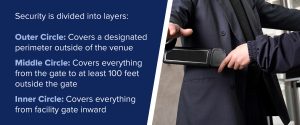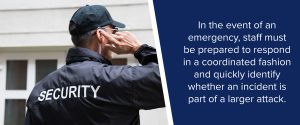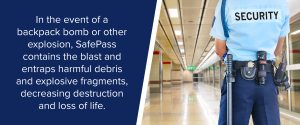
Sporting events have a long history as a target for violent extremists and terrorists. Today’s sports fans are used to going through layers of security procedures, from bag checks to pat downs. The threat of terrorism has prompted athletic venues to spend $2 billion per year worldwide on sports security.
REQUEST A QUOTE
However, athletic venues face ever-evolving risks. Terrorist tactics are constantly evolving and exposing stadiums to new attack methods. In May 2017, a bomber detonated a shrapnel-packed bomb inside the crowded foyer at Manchester Arena, killing twenty-three people and injuring 250. The bomb, thought to be detonated from the attacker’s backpack, allowed the attacker to hit a large group of people at a very close range and cause maximum possible destruction.
The Threat of the Backpack Bomber
Backpack bombs are presenting a new challenge for event venues in subduing terrorism. With backpack bombing, the attacker can be on the move and strike unexpectedly from any location. A backpack provides an easy cover to hide a bomb. As seen with the Boston Marathon Bombing, the attackers were able to plant two pressure-cooker bombs, hidden in backpacks, in a large crowd of marathon-watchers and leave the scene unnoticed. Before the bombs exploded, no one realized the danger hidden in their midst.
Backpack bombs also allow attackers to select locations with a large number of potential victims. Crowded public events like concerts, festivals and sporting events provide prime opportunities for terrorists to attack. Even the things designed to keep people safe, like security checkpoints, become a target for destruction. Any large gathering of people, such as around a checkpoint, is an easy target for an attacker, as the attacker can hit a large number of people in a consolidated area with a single device.
Improving Stadium Security
With terrorist threats growing and evolving, stadiums must constantly reevaluate and improve security approaches to protect from backpack bombers and other attackers. Venues should consider the following measures when designing their security procedures.
-
Establish and Maintain a Security Presence
Security presence is important. Stadiums have added visible layers of security, like bag checks, metal detectors and uniformed security personnel in an effort to stop terrorism at the gate. And these methods have proven effective — in October 2005, an individual tried to bring a backpack bomb into the University of Oklahoma football stadium. When faced with the mandatory bag search at the gate, the bomber left the scene and detonated the bomb outside.
While fans may grumble about the process of security checks, they also say they value the stadium environment, including sense of security, as the second most important part of the stadium experience, only behind on-field play. Visible security measures make it clear that security is the venue’s priority and help attendees feel protected. With security presence, people are more likely to speak up if they see anything out of the ordinary.

Venues often focus on how to handle crowds before an event, but the time during the event is just as critical. Recent attacks on public events have taken place once the event was underway. With the crowd focused on the main attraction and decreased security attention, attackers can act unnoticed.
Security screening should be consistent throughout the event. All persons entering the event venue should go through the same screening procedures, no matter what time they enter. Also, security measures should stay in place through the entire event, until the crowd is gone. Consistent screening not only helps stadiums ensure all attendees are screened equally, it shows vigilance and attention to security, which may discourage an attacker.
-
Avoid Creating Hubs
Areas that attract large, dense gatherings of people, such as transit connections, tailgate areas and merchandise locations, are prime targets for potential attackers. Crowded areas create a perfect cover for an attacker to go unnoticed. Think of a typical tailgate — there’s the blaring of music, the rumble of voices and the haze of grilling. People are consumed in their activities. With everything going on, an attacker can easily slip through the crowd.
Venues should avoid creating large gathering points and spread out populated locations. While crowds in certain areas are inevitable, keeping densely populated locations separated from one another makes it more difficult for an attacker to hit a single large target.
Consider additional security measures for crowded areas, such as surveillance equipment and on-site security personnel. On-site personnel is especially valuable — while security cameras can provide an overhead view, personnel on the ground can spot unusual behavior or suspicious objects. Keeping populated locations separate also makes the job of security personnel easier, as they can focus on securing a smaller, more consolidated area.
Also, be cognizant of the location of security command and communications. An onsite base for security and emergency response is a target. By taking out the command center for security, an attacker can inhibit the venue’s ability to respond in the case of an emergency. While it’s beneficial to have a security office in the stadium, locate the headquarters offsite, so in the event of an attack, personnel can safely organize and coordinate a response.
-
Have Eyes Everywhere
REQUEST A QUOTE
Security shouldn’t be limited to the gate. It’s critical that stadium security has eyes and ears on the ground both outside and inside the venue.

The National Center of Spectator Sports, Safety and Security (NCS4) recommends identifying Concentric Circles of Security. In this model, security is divided into layers:
- Outer Circle: Covers a designated perimeter outside of the venue
- Middle Circle: Covers everything from the gate to at least 100 feet outside the gate
- Inner Circle: Covers everything from facility gate inward
To put the Concentric Circles concept into practice, venues might start with a layer of vehicle screening, or restricted vehicle access to the venue. For the middle layer, venues might deploy security personnel to look for suspicious behavior before individuals get to the security checkpoint. Before entering the venue, visitors go through a security checkpoint, including bag checks, magnetometers and pat-downs. As the inner layer, security personnel monitor inside the venue for suspicious activity and potential threats.
While security cameras should never replace the role of on-site personnel, they can be a valuable tool in helping staff keep watch over public areas inside and outside the venue. If an attack occurs, security camera footage can be critical in helping investigators understand the attack and identify perpetrators.
-
Make Attendees Part of the Security Process
Attendees can act as extra sets of eyes and ears to alert security personnel of suspicious activity. Methods such as text message reporting have become a great outlet for venues to discreetly and safely communicate with fans experiencing problems in stadiums.
However, attendees can also make security’s job harder. Security personnel time and energy is often spent addressing non-critical issues. At bag checks, personnel have to deal with visitor after visitor attempting to bring in prohibited items. Most of these items are non-threatening — alcohol, noisemakers and open containers are common culprits. However, personnel can become complacent and less vigilant of potential criminals in the crowd. This also clogs security checkpoints, creating a large target for a potential attacker.
Visitors who understand security procedures can help security processes run more smoothly and effectively. There’s an element of buy-in here — when attendees know what to expect and why a process exists, they are more likely to see security as something positive that’s intended to keep them comfortable and safe, and work to comply with rules. Without proper communication, customers see security as a hassle.
Communication with guests is key. Stadiums should take advantage of advanced communication outlets such as ticketing vendors and public media.
-
Create a Unified Effort
A unified security force is key to successful emergency response. Personnel must understand their expectations and work together to follow security protocols. In the event of an emergency, staff must be prepared to respond in a coordinated fashion and quickly identify whether an incident is part of a larger attack.

The National Football League (NFL) has written its own Best Practices for Stadium Security, a set of recommendations that organizations should follow at their stadiums. The success of such a program depends on each staff member carrying out their job responsibilities in alignment with the NFL’s Best Practices guidelines. To ensure a unified implementation, the NFL conducts unannounced security reviews and rates clubs on their adherence to Best Practices guidelines.
Just like attendees, security personnel should understand why procedures are in place. They should be kept up to date on emerging threats and regularly rehearse emergency protocols. That way, if disaster strikes, they’re ready and prepared to respond.
Also, stadiums should write security policies that help security staff do their jobs well. For example, the NFL implemented a stadium bag policy, allowing only clear and small clutch bags into stadiums. This policy simplifies bag check procedures and gives staff easier oversight of guests entering the stadium.
To create the strongest possible security program, stadiums should consider holding regular independent assessments of security protocols to help them identify vulnerabilities. Staff members know the nuances of their own venues best, but can become nose blind to potential vulnerabilities. An outside evaluator can offer a fresh perspective and innovative approaches.
Protecting from Bomb Explosions with SafePass
In the face of increased terrorist threats, athletic venues must come up with methods for protecting guests, players and staff from stadium bomb explosions.
To help venues protect from backpack bombers, TM International offers SafePass, a blast shield that provides fire and explosion protection in security checkpoint lines. With SafePass, individuals can go through security screenings in an enclosed tunnel before entering the stadium. In the event of a backpack bomb or other explosion, SafePass contains the blast and entraps harmful debris and explosive fragments, decreasing destruction and loss of life.
SafePass is a permanent, low maintenance option for explosion protection. The tunnel is made from a double reinforced layer of woven steel, providing complete protection from fire and explosions. With its modular design, it can be easily customized to different formats and venue needs.
While it may never be possible to stop all bomb threats, SafePass gives venues a powerful tool for preventing casualties and containing damage in the event of an attack. For more information about this life-saving tool, contact a TM International representative today.





